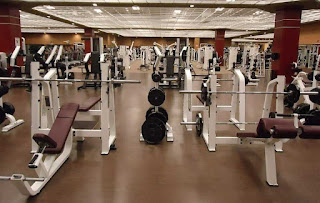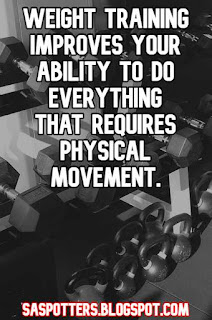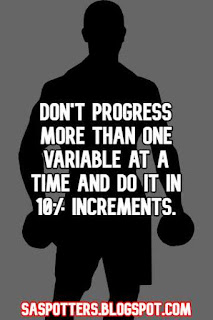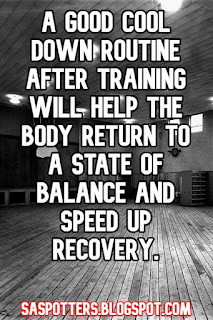This article is written by Rob Maxwell (learn about his education), M.A. Exercise Physiology, CSCS and ACSM CPT from www.fittothemax.net. Follow him on Twitter.
Weight training basics
Weight training is called many different things. Call it what you want. Just do it!
Other names for weight training
It can be called weight training, lifting, strength training or resistance training and/or working out.
The difference between weigh training, bodybuilding and power lifting
Bodybuilding is a sport, but it is weight training. I would also say that it is a lifestyle. Power lifting is a sport, but it is weight training. Weightlifting is a sport, but it is weight training.
What is weight training?
The key is that you train or exercise using resistance against a normal or slightly greater than normal range of motion.
What is DCER?
In Exercise Physiology words weight training is called DCER which stands for Dynamic Constant External Resistance.
This means that weight training needs to be a Dynamic (moving), Constant (tension stays on the muscles), External (the load comes from outside the body) Resistance (there must be a load).
Why weight training?
We know that weight training makes us stronger and adds muscle. Many people might think that it is not for them. It is.
Activities of Daily Living or ADL
At any age we need to pay attention to ADL’s - which stands for Activities of Daily Living. Some of our most common reasons for people wanting to work out with us after middle age are for their ADL’s.
We want to continue to do things, right? That is the Fountain of Youth part - or a big part of it. We want to remain independent to the best of our abilities and improve our quality of life.
Think about getting out of a chair. Do you think that it's no big deal? Well, I can tell you that I have seen too many seniors not being able to get up out of a chair as well as what they want to. That is a squat. If you work on squats and really improve them, getting out of a chair will stay easy. That is just one example.
The stronger we stay, the more our ADLs are improved.
The importance of muscle
Adding or keeping muscle is also critical. Why is that? Muscle is live metabolic tissue. The more muscle we have, the more calories we burn. It’s not about weight per se. It’s about muscle. The only way to increase our metabolism is to add muscle tissue.
CSA (Cross Sectional Muscle Area)
In the exercise world we call it CSA (cross sectional muscle area). Gaining and maintaining strength and keeping our metabolism high are the biggest reasons for strength training, but let me list all of the benefits.
Benefits of weight training
1. Strength for daily activities
2. Metabolism
3. Appearance
4. Self-esteem
5. Mood improvement
6. Confidence
7. Better at sports
8. Less likely to get injured
9. Social improvement
10. Burn calories
Types of weight training
Your body cannot really tell the difference with modes of weight training. Free weights are great. Dumbbells are great. Machines are great. Bands or tubes are great. Body weight is great.
1. Free weights
Free weights are great because many “famous” exercises are done with them; and younger athletes need to get proficient at these exercises to help them with scouting and performance.
They are also cheaper and mobile. The con is that if you do not have a spotter, they are harder to push to optimal levels for safety issues. There is also a learning curve with them.
2. Dumbbells
Dumbbells are great because you can train every muscle group with them. They are cheap and mobile. The con is that it is harder to do certain exercises with them because you might struggle with getting them up into the proper starting position of some exercises.
They also need a learning curve more than machines.
3. Machines
Machines are great because they train the muscle through the full-strength curve. They are easier to understand form on, they isolate the muscle well and they are great for gyms that have multiple people working out.
The cons are that they are expensive and do not replicate human movement as well. They also aren't mobile! Try moving a 500-pound leg press.
4. Band and tubes
Bands and tubes are great for mobility and travel. The cons are that they are not as objective when it comes to knowing how much load you are lifting and whether improvements are being made.
5. Body weight
Body weight is great for mobility and replicating many sports moves. The cons are they are hard to overload because once you can lift your weight, you can lift your weight.
All are great! The best workout will use different modes. Your body only knows that it is being fatigued and challenged. It is this challenge that leads to positive results.
Frequency: How often should you do weight training?
You need to do strength training two to three days per week. You also need to train each major muscle group two to three days per week.
There is much debate over whether you should do a full body workout program or split routine. A split routine means that you train more than three times per week and you work different muscle groups when you work out.
Do not fall into this debate. They are all effective and it really comes down to how much time you have in your week to work out and what your goals are. Both are effective.
The major muscle groups
The major muscle groups are the Glutes, Quads, Hamstrings, Pecs, Lats, Delts, Biceps, Triceps and Core.
They need to be trained two to three times per week. A minimum of 48 hours (about 2 days) will be needed between workouts for optimal recovery to occur.
Catabolism and anabolism
We break the muscle down during the workout. That is called catabolism. We grow, which is called anabolism, at rest.
If we do not rest, we do not grow. What about the split routine? It's the same thing. You must rest at least 48 hours (about 2 days) after working a certain muscle group before working it again.
Intensity: How hard should you weight train?
The muscle must be overloaded to get stronger, add muscularity and overall function of the muscle. This means that the muscle must be stressed more than it has been before.
We can overload in strength training by using more load, reps, sets, or different exercises. All are good. The most basic is load. Load is weight or resistance. I like to use the term load.
There are many ways to gauge intensity. We use percent of the 1 rep maximum for each exercise. That is great for athletics but not overly applicable when you do not do those kinds of strength tests in the beginning like you would for athletics.
Another way to measure intensity is by using what we call Rep Maximum. That means that whatever the rep goal is, you use the best load that you can for that rep amount. For example, 10 R M means that for 10 reps you are using the most weight you can use for that set and still maintain good form. That is far more applicable than percentage of 1 rep max.
Another way to think of intensity is to simply get as close to muscular failure as you can. Sets are meant to be taken to your best limit. When I think of intensity I really think of muscular failure. If you are going to failure or as close as you can, I can guarantee you that you are going hard enough.
Sets and Reps: How many should you do?
Sets in weight training
Keep in mind that your body cannot really tell too much of a difference if a certain threshold has been met. There are some differences.
Sets are so widely debated. Do not get too fat into this! Like many things, it depends. We are all individuals. We have guidelines, but it still comes down to working the muscles and feeling it.
In general, research shows that anywhere from one to five sets per muscle group works well. How much effort do you put in? The more effort you put in, the fewer sets you can do.
You can change it per muscle group too. Keep in mind that it is only a set if it is taken to fatigue. So warm-up sets do not count as sets. Warm-up sets are good, but they are not a set. The smaller the area, the fewer sets you need as well.
The most important variable is intensity. You cannot do a lot of volume (sets and reps) if the intensity is high. Sets are variable. Remember that we are all different. Stay within the guidelines and let your results dictate how many sets are right for you. You should do as few sets that bring you results.
Reps in weight training
What about Reps? Research shows that very low reps (<5 and all the way up to 25 reps or so) can bring great results.
Athletes trying to hit PR’s (personal records) in strength lifts can benefit from doing fewer than 5 reps.
Most people do not need to do that few or go that heavy. The ACSM suggests an ideal rep range of 8-12 - and 8-15 for “seniors”. That is a good guidepost because you get the best of all worlds in this rep range - which is strength, endurance and hypertrophy (tone/size).
As a rule, less than 6 reps promote maximal strength, 6-12 reps promote hypertrophy and general strength, and greater than 15 reps promote muscular endurance.
There is the rep continuum. This means that reps are not all or nothing. Even with as few as 5 reps, you are still getting some endurance but mostly strength. Even with as high as 25 reps, you are still getting some strength but mostly endurance and hypertrophy.
Find the best rep range that works for you on different exercises and mix it up. If you are going till failure in good form and keeping track of overload, you will get the best results.
Progression in weight training
If you stay the same, you will stay the same. If you increase too much too soon, you will break down and halt results.
We should never progress two variables at one time. In other words, do not increase sets and reps at the same time. Do not increase weight and reps at the same time. Increase one.
Which one should you increase? It comes down to your goals. If you want to increase strength, adding load is your best progression. If you want to increase endurance, then increasing reps is your best bet. If you want to increase size then adding volume is your best bet (sets or reps or extending a set). The key is to advance.
The 10% rule of progression in weight training
We use the 10% rule primarily with adding load. This is a good rule of thumb. This means that you should not increase by more than 10% at a time.
For example if you use 100 pounds for your work set and you want to get stronger; add 10% which would be 10 pounds. Your new load is 110 pounds. You will then improve without breaking your body down.
A program is important for your fitness. Yes, I believe in listening to my body - but it is often the body that I ignore and I listen to my ego instead. "More! More! More!" it screams.
If we follow little rules like the 10% rule or not increasing more than one variable at a time (load, reps, sets); we will make gains without overtraining.
Periodization in weight training
Periodization means to build change into the workout plan. You get classical periodization and non-linear periodization.
Classical periodization
There is classical periodization which means that you build a program for around three months (or longer) and each month the program gets systemically more intense.
Within each month of the three months, the weeks get progressively harder as well. Each month will have a focus that will prepare the body for the next month that will be more intense.
Classic periodization uses three cycles: a macrocycle, mesocycle, and microcycle.
The macrocycle is the overall program and typically spans from 6-12 months. The mesocycle fits inside the macrocycle and each is typically 1-2 months. The microcycle fits inside the specific mesocycle and is typically one week at a time.
This program is good for athletes and for programs where a person is not going to have as much daily contact with a trainer, but they want a progressive plan that will help them steadily make progress.
Non-linear periodization
Non-linear periodization is not as structured. It uses different rep ranges and intensities within the workout week.
For example you may have a light day on Mondays and do high reps with lighter weights. On Wednesdays you may have a medium day and do moderate rep ranges of 8-12 with slightly heavier weights. Friday may be a heavy day with lower reps and heavier weights.
This style is great when you do not have a specific season to prepare for if you are an athlete.
Which form of periodization is better?
Both ways to program are good. The big take away about periodization is to change. Doing the same thing all the time can lead to physical and mental stagnation. Change is good.
We like to mix it up with our clients. I typically will not do the same reps all of the time. It is good to change it up. The more formal your training is (for athletics as an example), the more structured this needs to be planned out because of all the other activities going on.
Most people will not need to formally plan this stringently. The non-linear periodization of doing different rep ranges on different days can apply to anybody.
Warming-up and cooling down
Just like with all other forms of exercise, you need to warm up prior to weight training. A general warm-up of at least five minutes is good. Elevate your core temperature with light cardio.
You may need to do specific warm-ups as well. If you are going to do a goblet squat exercise and you use 30 pounds as your main weight, you need to do a body weight set first. This is true with all exercises. The heavier the load is going to be on your work set, the more likely you will need a warm up set.
After weight training you need to cool down. This is like your general warm up - do light cardio exercise after your workout.
When we cool down, we return our bodies to homeostasis. This allows us to recover better so that we can promote growth. A good time to cool down is five to fifteen minutes - depending on your time and how hard you worked out.
This article is written by Rob Maxwell (learn about his education), M.A. Exercise Physiology, CSCS and ACSM CPT from www.fittothemax.net. Follow him on Twitter.











Thanks for the information you shared.
ReplyDelete